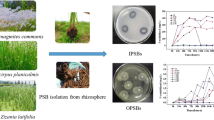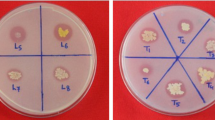Abstract
We isolated and characterized novel insoluble phosphate (P)-solubilizing bacteria tolerant to environmental factors like high salt, low and high pHs, and low temperature. A bacterium M6 was isolated from a ginseng rhizospheric soil and confirmed to belong to Burkholderia vietnamiensis by BIOLOG system and 16S rRNA gene analysis. The optimal cultural conditions for the solubilization of P were 2.5% (w/v) glucose, 0.015% (w/v) urea, and 0.4% (w/v) MgCl2·6H2O along with initial pH 7.0 at 35°C. High-performance liquid chromatography analysis showed that B. vietnamiensis M6 produced gluconic and 2-ketogluconic acids. During the culture, the pH was reduced with increase in gluconic acid concentration and was inversely correlated with P solubilization. Insoluble P solubilization in the optimal medium was about 902 mg l−1, which was approximately 1.6-fold higher than the yield in NBRIP medium (580 mg l−1). B. vietnamiensis M6 showed resistance against different environmental stresses like 10–45°C, 1–5% (w/v) salt, and 2–11 pH range. The maximal concentration of soluble P produced by B. vietnamiensis M6 from Ca3(PO4)2, CaHPO4, and hydroxyapatite was 1,039, 2,132, and 1,754 mg l−1, respectively. However, the strain M6 produced soluble P with 20 mg l−1 from FePO4 after 2 days and 100 mg l−1 from AlPO4 after 6 days, respectively. Our results indicate that B. vietnamiensis M6 could be a potential candidate for the development of biofertilizer applicable to environmentally stressed soil.





Similar content being viewed by others
References
Ausubel FA, Brent R, Kingston RE, Moore DD, Smith J, Seidman JG, Struhl K (1988) Current protocols in molecular biology. Wiley, New York
Banik S, Dey BK (1983) Phosphate solubilizing potentiality of the microorganisms capable of utilizing aluminium phosphate as a sole phosphate source. Zentralbl Mikrobiol 138:17–23
Bar-Yoself B, Rogers RD, Wolfam JH, Richman E (1999) Pseudomonas cepacia-mediated rock phosphate solubilization in kaolinite and montmorillonite suspensions. Soil Sci Soc Am J 63:1703–1708
Clesscerl LS, Greenberg AE, Eaton AD (1998) Standard methods for the examination of water and wastewater. APHA-AWWA-WEF, Washington
Das K, Katiyar V, Goel R (2003) P solubilization potential of plant growth promoting Pseudomonas mutants at low temperature. Microbiol Res 158:359–362
Del Campillo SE, Van der Zee S, Torrent J (1999) Modeling long-term phosphorus leaching and changes in phosphorus fertility in excessively fertilized acid sandy soils. Eur J Soil Sci 50:391–399
Gaind S, Gaur AC (1991) Thermotolerant phosphate solubilizing microorganisms and their interaction with mungbean. Plant Soil 133:149–153
Gerhardt P, Murray RGE, Costilow RN, Wester EW (1981) Manual of methods for general bacteriology. Americal Society for Microbiology, New York
Goldstein AH (1986) Bacterial solubilization of mineral phosphates: historical perspectives and future prospect. Am J Alter Agric 1:51–57
Goldstein AH (1995) Recent progress in understanding the molecular genetics and biochemistry of calcium phosphate solubilization by gram negative bacteria. Biol Agr Hort 12:185–193
Illmer P, Schinner F (1995) Solubilisation of inorganic calcium phosphates; solubilisation mechanisms. Soil Biol Biochem 27:257–263
Johri JK, Surange S, Nautiyal CS (1999) Occurrence of salt, pH, and temperature-tolerant, phosphate-solubilizing bacteria in alkaline soils. Curr Microbiol 39:89–93
Kucey RMN (1988) Effect of Penicillium bilagi on the solubility and uptake of P and micronutrients from soil by wheat. Can J Soil Sci 68:261–270
Kumar V, Behl RK, Nurula N (2001) Establishment of phosphate solubilizing strains of Azotobacter chroococcum in rhizosphere and their effect on wheat cultivars under greenhouse conditions. Microbiol Res 156:87–93
Leyval C, Barthelin J (1989) Interaction between Laccaria laccata, Agrobacterium radiobacter and beech roots: influence on P, K, Mg and Fe mobilization from mineral and plant growth. Plant Soil 17:103–110
Lin TF, Huang HI, Shen FT, Young CC (2006) The protons of gluconic acid are the major factor responsible for the dissolution of tricalcium phosphate by Burkholderia cepacia CC-A174. Biores Technol 97:957–960
Nahas E (1996) Factors determining rock phosphate solubilization by microorganisms isolated from soil. World J Microbiol Biotechnol 12:567–572
Nautiyal CS (1999) An efficient microbiological growth medium for screening phosphate solubilizing microorganisms. FEMS Microbiol Lett 170:265–270
Omar SA (1998) The role of rock-phosphate-solubilizing fungi and vesicular-arbuscular-mycorrhiza (VAM) in growth of wheat plants fertilized with rock phosphate. World J Microbiol Biotechnol 14:211–218
Reiter B, Oram JD (1962) Nutritional studies on cheese starters. J Dairy Res 29:63–77
Rodriguez H, Fraga R (1999) Phosphate solubilizing bacteria and their role in plant growth promotion. Biotechnol Adv 17:319–333
Rodriguez H, Gonzalez T, Selman G (2000) Expression of a mineral phosphate solubilizing gene from Erwinia herbicola in two rhizobacterial strains. J Biotechnol 84:155–161
Saleena LM, Loganathan P, Rangarajan S, Nair S (2001) Genetic diversity and relationship between Bradyrhizobium strains isolated from black gran and cowpea. Biol Fertil Soil 34:276–281
Son HJ, Park GT, Cha MS, Heo MS (2006) Solubilization of insoluble inorganic phosphates by a novel salt- and pH-tolerant Pantoea agglomerans R-42 isolated from soybean rhizosphere. Biores Technol 97:204–210
Song OR, Lee SJ, Lee YS, Lee SC, Kim KK, Choi YL (2008) Solubilization of insoluble inorganic phosphate by Burkholderia cepacia DA23 isolated from cultivated soil. Braz J Microbiol 39:151–156
Stumm W, Morgan JJ (1995) Aquatic chemistry. Chemical equilibria and rates in natural waters, 3rd ed. Wiley, New York
Suh JS, Song YS, Kim KS (1995) Distribution of phosphate fractions in greenhouse soils located on southwest region in Korea. J Kor Soc Soil Sci Fert 23:270–277
Thompson JD, Gibson TJ, Plewniak F, Jeanmougin F, Higgins DG (1997) The Clustal X windows interface: flexible strategies for multiple sequence alignment aided by quality analysis tools. Nucleic Acids Res 24:4876–4882
Vassilev N, Vassileva M (2003) Biotechnological solubilization of rock phosphate on media containing agro-industrial wastes. Appl Microbiol Biotechnol 61:435–440
Vassilev N, Vassileva M, Nikolaeva I (2006) Simultaneous P-solubilizing and biocontrol activity of microorganisms: potentials and future trends. Appl Microbiol Biotechnol 71:137–144
Vyas P, Rahi P, Chauhan A, Gulati A (2007) Phosphate solubilization potential and stress tolerance of Eupenicillium parvum from tea soil. Mycol Res 111:931–938
Author information
Authors and Affiliations
Corresponding author
Rights and permissions
About this article
Cite this article
Park, KH., Lee, OM., Jung, HI. et al. Rapid solubilization of insoluble phosphate by a novel environmental stress-tolerant Burkholderia vietnamiensis M6 isolated from ginseng rhizospheric soil. Appl Microbiol Biotechnol 86, 947–955 (2010). https://doi.org/10.1007/s00253-009-2388-7
Received:
Revised:
Accepted:
Published:
Issue Date:
DOI: https://doi.org/10.1007/s00253-009-2388-7




